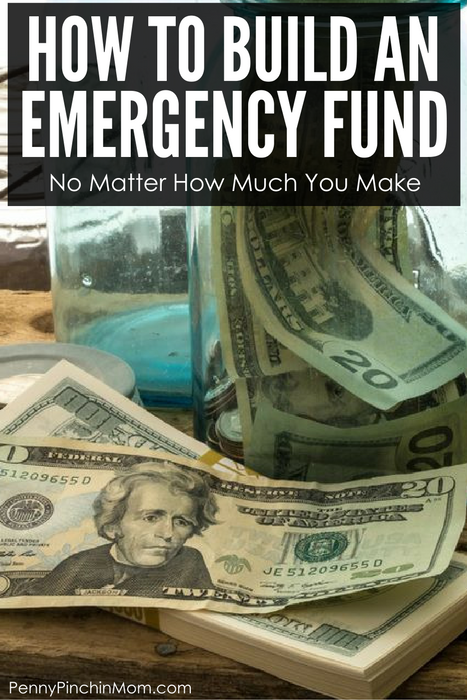Learn how to build your emergency fund and find out why it is so important that you start this today.
Whether you are in debt or not, you need to be prepared for the unexpected. How does one do this? Simple. With an emergency fund.
In fact, if you are in debt and working to be come debt free, it is even more important that you have this in place before you begin to tackle your debts. The reason is that you need to have funds in place in case you need them. In fact, if you are in debt, it is imperative that you do what you can to get $1,000 in the bank before you work on paying down debts.
What is an emergency fund?
So, what is an emergency fund? It is money that you have saved for, well, an emergency. Some examples could include the furnace going out, your refrigerator needing repair, etc. Items that aren’t emergencies are a flat screen TV marked way down, new soccer cleats for your child or a vacation to Mexico. Those items are wants and you should save for them separately.
For most, the reason to maintain an emergency fund is in the case of job loss. Since it may take longer to find new employment, you need money to carry you through. Having an emergency fund is one simple way to do this.
How much do you need in an emergency fund?
If you do not yet have any emergency fund, you should start as soon as possible. In fact, if you are in debt, you need to do what you can to get at least $1,000 in the bank. If you read further, we have some ideas on things you can do to help build up your own account. That will be a base to cover an emergency should it arise and you will not have to go further into debt just to cover those expenses.
As you get out of debt and are more financially stable, you will need to save more. Several years ago, when the job market was stronger, 3-6 months was the norm. However, with the way things are now, it is best to have at least 6 months of your monthly income if you are single and upwards of nine months if you are providing for a family.
That may seem unattainable, but you can do it! Keep in mind that the actual dollar amount will vary from person to person. What you should do is look at your monthly budget. If you happen to be out of work, which items do you no longer need (maybe you could drop cable or stop dining out). Make sure you also add in those items you need to cover yourself such as health insurance premiums. Once you see your new budget, take that amount x6 to determine 6 months of savings, or however many months you are trying to save.
Do you need a separate account for emergency savings?
For some people, it is simpler to have two different savings accounts. One account is for regular savings for items to purchase during the year such as taxes, birthdays, holidays, insurance, etc. Then, a separate account is set up to keep emergency money only. This way, when they need the money, they know they are drawing it from the correct account.
However, for others, it will not matter as savings is savings. If you do keep just one account, it is best to make sure that your fund never drops below a minimum amount, such as $1,000. That way, you know you always have money ready if it is needed.
What can you do to build an emergency fund?
There are so many different ways to build an emergency fund! What is the most important thing to remember is that when you get paid, always take a moment to pay yourself. Even if you can save just $100 a month, you will have $1,200 saved in just one year!
1. Sell items. Look around your home and see what you have that you might be able to sell. Do you have kids’ toys you no longer need? Perhaps you have furniture that you are not using. You can either have a garage sale or just list them for sale on websites such as Craigslist (just be careful when selling items so you are safe). When you are in debt and/or you need emergency money, you need to look at the wants in your life rather than the needs and pare down to get out from under financial troubles.
2. Find a part-time job. You might find that your local retail store or even a local pizza shop is hiring part-time workers. You can get an additional job and use that money to just build your emergency fund (and then later, use the income to pay off your debt).
For some, this may not be an option, so you might be able to find one of these Ten Ways to Make Money from Home work for you. The best way to make more money is to find your passion and then turn that into a way to make money. Passion will carry you through and help you stick to it!!!
3. Adjust your budget. There are things you can do to save money on your monthly budget. You can work harder to save money at the grocery store by using coupons. Follow our site to find out ways to do just that. We share many tips and even in-store deals to help you get those items you need for as little money out of your pocket as possible.
You can also take steps to reduce your monthly utilities. We’ve got a great post here with Ten Ideas to Help You Reduce Your Utility Bills. Take that monthly savings and put it into your emergency fund.
4. Stop dining out. If you spend $100 – $200 a month dining out, that is a lot of money! If you take those funds and just put them into savings instead, you will have reached your emergency fund savings goals sooner than you realize!! When we were getting out of debt, we did not eat dinner out but a few times a year. Difficult? Yes! Worth it? More than you realize!!! Follow your own menu plan and figure out what your family will have for dinner that week without dinner away from home! You can read more about Menu Planning here.
5. Don’t go to the store. This may sound extreme, but it works. Try to just visit your grocery store just once a week – and stick to your shopping list. When you visit the store more frequently, you will usually end up spending money on items you may not really need. By sticking to your shopping list, you will stay on budget and not end up overspending when you don’t want to.
Doing what you can to build up your emergency savings account before you do anything else. I know it takes time, but remember that this is not a race to the finish line. In the case of financial freedom, slow and steady always wins the race.
(I am not a financial advisor and the information listed within these Debt Challenge posts is not to be construed as financial advice. This is knowledge we gained through our own personal experiences and information as outlined in Dave Ramsey’s Financial Makeover — and is being shared as such. Participants are not required to follow any steps listed if they do not wish to do so. Financial concerns/issues should be addressed with a professional in order to receive advice and assistance.)



